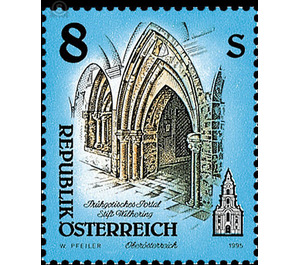Works of art from monasteries - Austria / II. Republic of Austria 1995 - 8 Shilling
Theme: Architecture
| Country | Austria / II. Republic of Austria |
| Issue Date | 1995 |
| Face Value | 8.00 |
| Color | blue |
| Printing Type | combination printing |
| Stamp Type | Definitive |
| Item Type | Stamp |
| Chronological Issue Number | 1512 |
| Chronological Chapter | OOS-OE2 |
| SID | 230500 |
| In 90 Wishlists | |
The Cistercian Abbey of Wilhering is located in the Danube Valley in front of Linz, the capital of the Austrian capital, and celebrates its 850th anniversary in 1995. It is best known for its rococo church. Built in 1734-1750 on the foundations of the old church destroyed by fire, the building is a popular attraction, above all for its splendid interior design. The sumptuous Rococo scenario, which fascinates visitors most of all today with Wilhering, actually overshadows those 600 years before the baroque era. A period that has much more to do with the Order than in the course of the Counter Reformation in the 17th and 18th centuries resulting magnificent buildings and decoration orgies, because originally it was above all characterized by simplicity and inward spirituality, the pen in the 12th century marked. A structural element from this period can also be seen as a brand motif: The early Gothic portal, discovered and uncovered in the cloister in 1938, was uncovered with the two window openings at the entrance to the chapter house.


